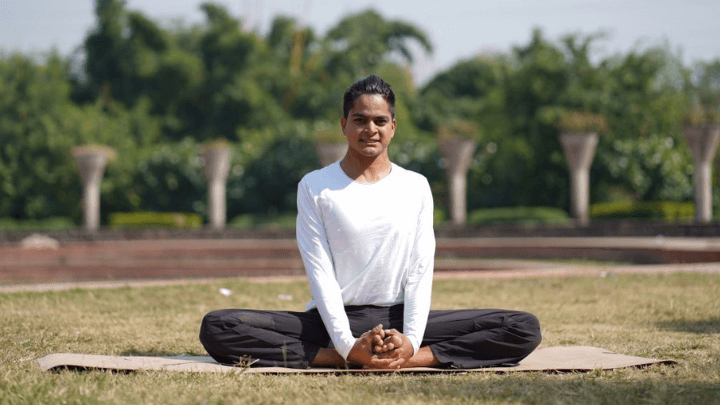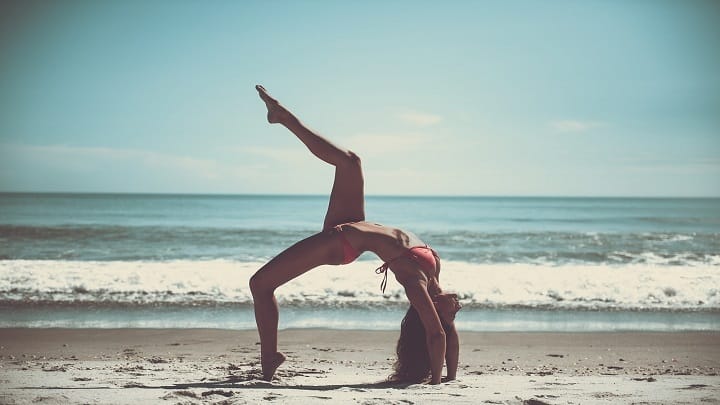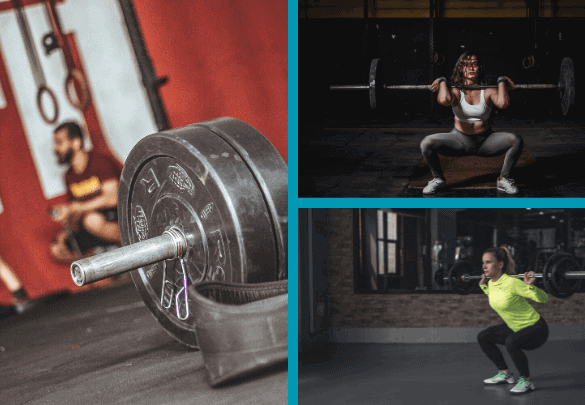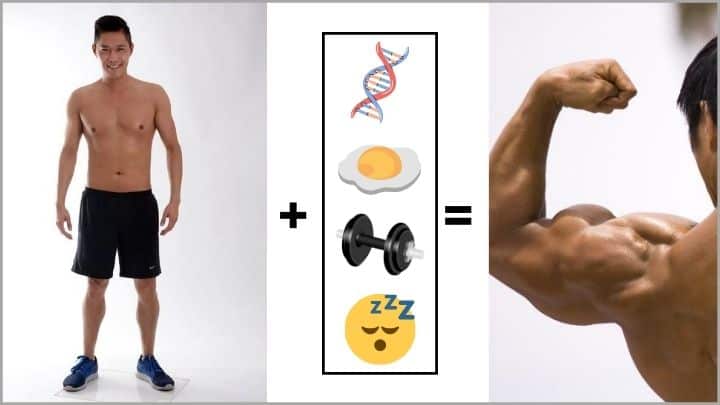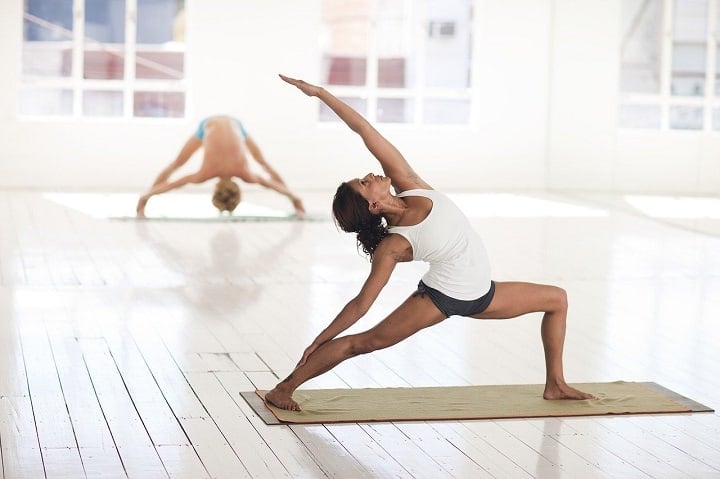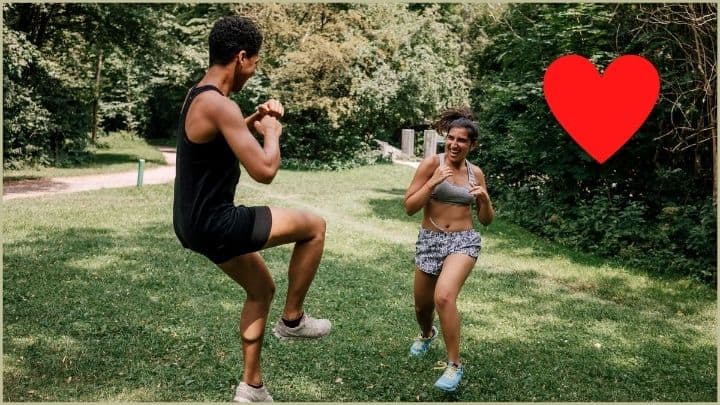This is the most complete guide to Bound Angle Pose (Baddha Konasana) online.
If you want to:
- See video/text-based examples of how to do Baddha Konasana
- Get access to the most frequently asked Bound Angle Pose questions
- Find examples of how to move from Bound Angle Pose to other poses
Then you’ll love the detailed insights in today’s guide.
Let’s get started!
What is Bound Angle Pose?
Also known as Baddha Konasana (derived from the Sanskrit words; Baddha – bound, Kona – angle and Asana – seat or posture); Bound Angle Pose is a classic seated pose that opens your hips and stretches your groin and inner thighs.
Bound Angle Pose is a foundational sitting pose. It prepares you for seated meditation, an important aspect of yoga practice, by strengthening your lower back, toning your core muscles and creating more flexibility in your hips.
By practicing Bound Angle Pose, you can improve your posture by aligning your spine properly and toning the muscles of your back and core.
Let’s now take a look at how to master this simple yet effective pose, along with some variations!
How to Do Bound Angle Pose (Baddha Konasana)
Disclaimer: Whilst Baddha Konasana is suitable for most people, if you are suffering from lower back injury, are pregnant, or not used to physical activity; always consult your doctor before making a change in your lifestyle.
1. Sit up straight in an upright position.
2. Bring your heels as close to your groin as possible. Press the soles of your feet together and let your knees naturally open out to the sides.
3. Grasp with both hands onto your two feet. Use your arm strength to actively lengthen your spine and open your chest by actively pressing your heart forward.
4. Press your shoulders down away from your ears.
5. Whilst maintaining an open chest, actively press your knees down and out to the sides without forcing them into an uncomfortable position. Keep the soles of your feet together.
6. Relax your arms and rest your hands (palms up or palms down) on top of your knees.
7. Breathe deeply and gaze fixedly at a point in front of you. If you feel discomfort, keep breathing deeply for at least 5 breaths. If you feel pain, ease out of the pose and take a rest before trying it again.
Bound Angle Pose Modifications for Different Body Types
I have taught yoga for over twenty years. In all my years of observing people, whether beginners or advanced practitioners, Bound Angle Pose looks different for every student and is the one pose that lends itself most to modification for different body types.
The most important point I always emphasize in my classes is to sit up straight with an open chest, no matter how flexible you may be in your hips, inner groin, or knees.
Whether you have tight hips or flexible hips, you can always modify this pose so that it is comfortable for you to practice and still get all the great benefits.
Here’s how:
If you feel strain in your knees: Elevate your feet by placing a pillow or folded blanket underneath them
If you feel discomfort in your hips: Sit on a folded blanket
If you feel overstretched in your inner thighs or groin: Place a yoga brick underneath your feet
If you have a groin or knee injury: Place a folded blanket, bolster (pillow) or yoga brick underneath both knees to avoid overstretching
If you are pregnant: Try “Wall Butterfly” — press your buttocks and feet against a wall, press your feet together, and let your knees fall to the sides. You can press your hands against your knees to deepen this variation.
How Long Should You Hold Bound Angle Pose For?
Hold Bound Angle Pose for 5 slow, deep breaths, then relax for 40-60 seconds.
How Often Can You Do Baddha Konasana?
If you are a beginner, limit Baddha Konasana to two times maximum in one practice session/day because you can easily overstretch.
If you are an advanced yoga practitioner, it is likely that you have well-developed flexibility in your hip, knee, inner thigh and groin region. If this is the case for you (as it is for me after doing yoga for 20+ years), then you can repeat Bound Angle Pose as many times as you want.
As an advanced student of yoga, I find myself naturally sitting in this position throughout the day, because it feels comfortable and easy for my body. But don’t get me wrong: it took my several years of practice before I could achieve this level of comfort in Bound Angle Pose!
In fact, this pose is also known as “Cobbler’s Pose“, the position in which shoe cobblers traditionally work in India. It is also an acceptable pose for practicing seated meditation.
Bound Angle Pose Variations
Flowing Bound Angle Pose
1. Come into Bound Angle Pose as described above.
2. Sit up straight and maintain an open chest by pressing your heart forward.
3. Use modifications (folded blanket or yoga bricks) as necessary to make your posture as comfortable as possible.
4. Inhale whilst raising your arms up overhead in a wide, sweeping arc. Take the length of your inhale to raise your arms up until your palms are touching and your gaze is up to your hands.
5. Exhale whilst releasing your arms back down to your sides in a wide, sweeping arc. Take the length of your exhale to release your arms back down to rest on your knees.
6. Repeat this action, inhaling your arms up and exhaling your arms down, for at least 5 full cycles of breath or until you start to feel uncomfortable in the pose.
How to Transition From Bound Angle Pose to Forward Bending Bound Angle Pose
1. Come into Bound Angle Pose as described above.
2. Press your hands onto your mat on either side of your feet.
3. Lengthen your spine and extend your chest and head in a straight line directly over your feet whilst pressing your hands down onto the ground.
4. Press your shoulders down away from your ears.
5. Continue to lengthen your spine as you extend your head and chest over your feet, bringing your chest gradually closer to your feet without forcing the stretch.
Note: Don’t worry about how far you can stretch. Instead, focus on breathing into the sensations. If you can bring your forehead all the way to the ground, then do it, but do not force anything. If you have the flexibility necessary to bring your forehead all the way down, then open the soles of your feet like a book and press your chest onto the soles of your feet. (Side note: this is an advanced version.) Whatever level of stretch you can achieve in Forward Bending Bound Angle Pose, be sure to keep breathing deeply and avoid overstretching.
How Do You Recline in Bound Angle Pose?
Here is how to transition from Forward Bending Bound Angle Pose to Reclined Bound Angle Pose:
1. From your version of Forward Bending Bound Angle Pose, press your hands onto the ground as you raise your head and chest up, easing back into classic seated Bound Angle Pose as described above.
2. Bend your knees and place both feet flat on the floor as you press your hands down beside your hips.
3. Ease back onto your forearms whilst pressing your feet into the ground.
4. Lie all the way onto your back comfortably and bring your heels together as close as possible to your inner groin, allowing your knees to press out to the sides and the soles of your feet to press together.
5. Rest your hands against your inner thighs to support the stretch. If you feel hip or knee discomfort, try one of the modifications for different body types: Place a folded blanket, pillow or yoga bricks under each one of your knees so that you can “rest” in this pose.
6. Keep breathing deeply, especially if you feel slight discomfort. If you feel pain, you should ease out of the pose and rest before trying it again.
What Are the Benefits of Bound Angle Pose (Baddha Konasana)?
Bound Angle Pose is the best sitting pose to help open your hips. It allows you to undo the effects of sitting for long hours in a chair or driving.
Mentally, Bound Angle Pose helps train you to “be with the discomfort” of daily life because the pose itself requires you to sit with any discomfort in the hips, inner thighs and knee joints as you gently stretch.
It helps:
- Stretch the hips, inner thighs and knees
- Improve circulation in the pelvis, relieving menstrual cramps
- Open up the connective tissues in your hips and knees
- Alleviate fatigue
- Energize your body and mind
- Reduce stress and anxiety
Even if your movement is limited, Bound Angle Pose can be modified to suit your particular body type. The pose will allow you to stretch the most important joints in your body whilst toning your back and core muscles.
Can I Do Bound Angle Pose During Menstruation?
Yes, Baddha Konasana is a hip-opening pose that soothes menstrual symptoms like cramping and lower back pain by gently stimulating your entire abdominal region, thereby relieving fatigue associated with menstruation.
Who Should Not Do Bound Angle Pose?
Bound Angle Pose is contraindicated if you have a recent knee, hip, or back injury.
As with all postures, listen to your body when you practice and if anything feels uncomfortable, then stop immediately or ask your instructor to help you modify the pose.
What Muscles Does Bound Angle Pose Work?
Bound Angle Pose strengthens your core muscle because you must activate this area in order to prevent your lower back from rounding in this pose.
Also, as this is an upright, seated posture that requires you to maintain a straight spine and open chest, you are able to strengthen your back and thigh muscles.
Why Is It Called Cobbler’s Pose?
In India, shoe cobblers traditionally work in a position that resembles this yoga pose. As shoe cobblers work in a seated position, this yoga pose is a common position for seated meditation.
Conclusion
Bound Angle Pose is a great pose to stretch your hips and prepare you for an extended time in seated meditation.
This pose will help strengthen your mental toughness when life presents uncomfortable challenges because it helps you “breathe into sensations”—no matter how intense or uncomfortable—especially in your hips and inner thighs.
This is a great stretch to undo the negative effects of long hours of sitting, which can cause your hips to get tight and less flexible.
By practicing Bound Angle Pose, you not only stretch needed areas of your body, but you also energize your mind and strengthen your mental ability to withstand the challenges of everyday life!
Now I’d love to turn it over to you:
- What do you like the most about Bound Angle Pose?
- When are you going to try it?
- Perhaps you’d like to share your experience with Baddha Konasana?
What Next?
Why not check out some more Yoga poses that can help improve your flexibility and strength for specific sports like Badminton – Yoga For Badminton Players
Let me know by leaving a comment below and remember to follow us on Instagram for more great content.

